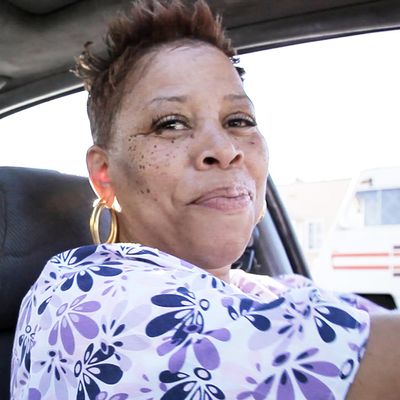
How did one of America’s most prolific serial killers get away with it for so many years? That’s the question acclaimed British documentarian Nick Broomfield sought to address after learning about the Grim Sleeper, who operated in South Central L.A. from the ‘80s through 2010, when a man named Lonnie Franklin Jr. was arrested in connection with ten murders. When police raided his apartment, they found thousands of photos of naked women, conscious and unconscious, and now believe he may have killed dozens more.
When the Grim Sleeper started killing women, crime and crack were rampant in South Central L.A. Many believe the lack of police investigation and media coverage has to do with the fact that the Grim Sleeper — so named because he appeared to take a 13-year break that is now in dispute — killed poor, black women, most of them drug addicts or sex workers. “I’m a black woman, who gives a fuck about me,” says Pam Brooks, a community member and former sex worker who helped the filmmakers find their sources.
When Broomfield began looking into the story, he was shocked to learn that the LAPD knew they had a serial killer on their hands in 1987, but didn’t release this information to the public until August 2008, 21 years later. And Franklin’s arrest wasn’t the result of thorough investigative work, but an accident — a routine computer DNA match linked him to as many as 20 possible victims.
The Cut spoke with Broomfield about Tales of the Grim Sleeper, which debuts tonight on HBO.
Was this always going to be a story about the community in South Central L.A.?
Initially, I thought it was going to be more on Lonnie [Franklin] himself. The police were so uncooperative, they made it so impossible for us to talk to forensics and they denied me access to Lonnie. In a way I’m really grateful to them, they forced me to make a much more powerful film.
You live in L.A., but not South Central, were you surprised by how different it is from your own community?
It’s like a completely different world from the white city five miles away. There’s massive unemployment and most people don’t graduate from high school. The sad truth is, you hardly see any young black males on the streets. They’re all locked up.
Normally, the only white people that go into this community are the police or the customers for the girls. Neither of them are particularly popular. I think it was important to register that and show how our presence was initially so contested.
That was one aspect of the film I really appreciated — that viewers don’t just see the interviews you garnered after months of conversation, but also the process of getting people to trust you and open up. Was the process orientation intentional?
Yes. Too many documentaries these days are of beautiful shots and people sitting on chairs, telling everything in the past tense. I think documentary is such an exciting medium because it’s very spontaneous and it should really chart the process of making a film. Through that, you can see people in the community change their orientation toward us.
The star of the film is definitely Pam Brooks, a community member and former sex worker who, at one point, you say is “basically running production.” How did you begin working with her?
We had a rather run-down office in the area and people would drop in around lunchtime, hoping we’d take them out for a meal. Pam would come by to play dice with Barney [Broomfield’s son] and that’s when she started going out with us on the rides. Having her in the car changed us from being narcs or johns into people that women would talk to. That’s how we got interviews with so many of the prostitutes in the area. Pam knew half of them, and the other half she’d just start talking to as soon as we pulled up.
One of the most shocking elements of the film was learning the term “NHI.” Can you explain what it means?
NHI is police slang for No Human Involved. When they radio something in, it’s always abbreviated. NHI is used when a prostitute or drug addict is killed. It means, pick the body up, don’t really bother doing proper forensics; this won’t need anything more than a cursory examination. The police don’t see these women as people. When community members raised concerns in the ‘80s, police were like, “Why are you so worried? He’s just killing prostitutes.”
At one point, Lonnie’s son says that the police admire Lonnie. How does that fit in?
In the police’s eyes, Lonnie is cleaning the streets, so to speak. He’s doing what so many police wish that they could do, rather than arresting the same people in and out every week. Occasionally, Lonnie would leave notices on the victims saying “crack head” or “whore” or “trash.” Police also see these women as disposable; their deaths are NHI.
A number of women you interviewed said, “If a white woman were killed, this would be a different story.” How do you think this story would have played out differently if Lonnie hadn’t been killing only black women?
If a white woman had been killed they would have closed down the entire city to figure out who was committing the murders. They would have brought in special federal units, and they would have solved it quickly.
Why didn’t they tell the community for so many years?
When I asked former Police Chief Bernard Parks, he said, “Oh, we didn’t want to tip off the serial killer.” And I was like, “Really … what, for 20 years?” They put this whole community in danger. Many deaths could have been prevented.
Police reports suggest only one woman escaped. Were you surprised to find others?
I was amazed. Because the police are so out of touch with the community, they really don’t know whether a certain number of women are alive or not. The women are terrified of the police, so they don’t go and say, “Well, actually I’m alive and this is what happened with Lonnie.” They’re worried about getting booked for being on the streets.
You began filming before the Ferguson protests, and I wonder how you think the LAPD’s documented indifference to a serial killer murdering only poor, black women fits in with the concerns raised in Ferguson. Is over-policing the flip side of the same coin?
Yes. They’re completely part of the same story. It’s been screened in Ferguson and people there felt like it reflected what they’ve been experiencing. They see police protecting the white communities, but in black communities, policing is just about handing out speeding tickets, parking tickets, harassing people, and making money. I get the feeling that this is the beginning of a movement to change things. Sooner or later, they’re going to have to lock some police up for what they’ve done and what they’ve failed to do.
This interview has been edited and condensed.




